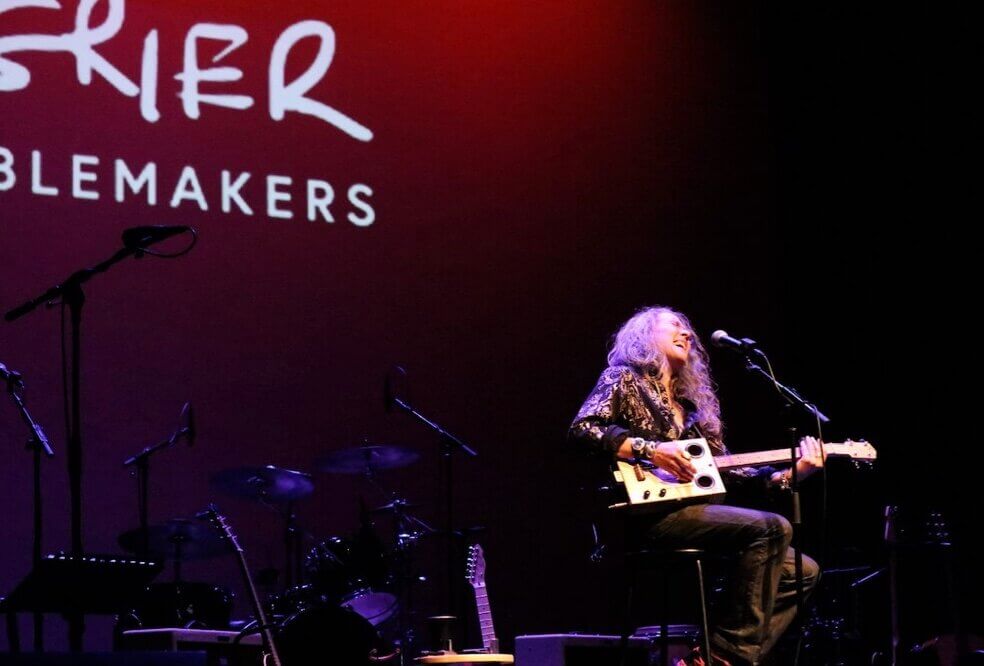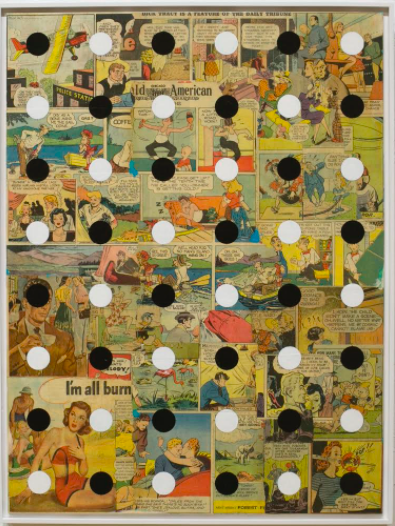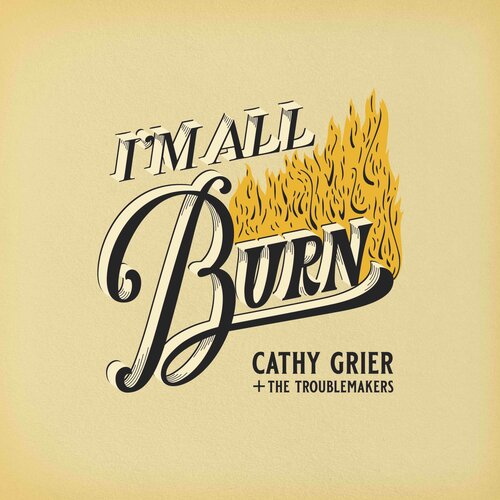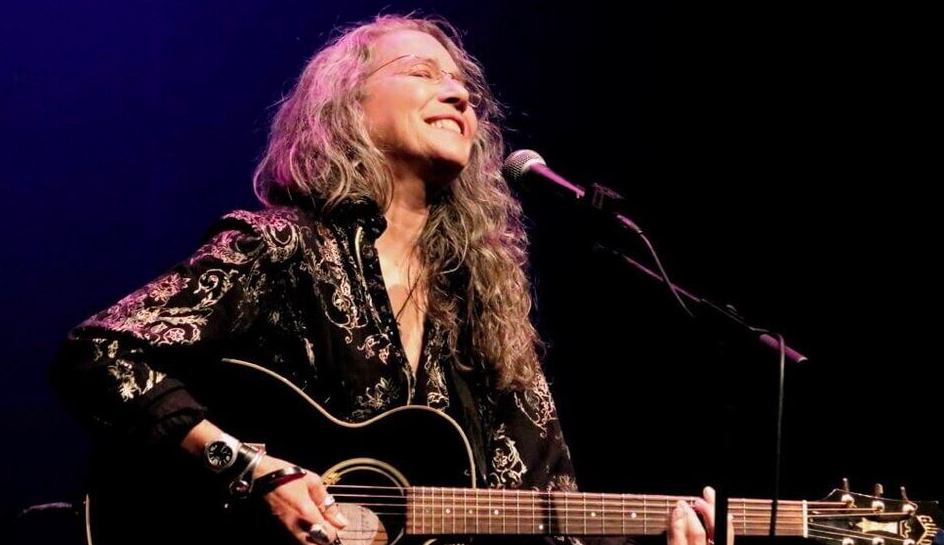Singer-songwriter and guitar ringer Cathy Grier connected with the blues at an early age. At just 17, she had an encounter with John Lee Hooker that proved to be a landmark moment in her life. A professional musician since 1978, she acuminated her skills — both acoustic and electric — in New York City subways. Grier’s career has seen wide-ranging high points such as opening up for The Band, landing an MTV video in the ‘80s, and being featured on CBS News Sunday Morning.
Asking Grier to narrow down a list of influences is like asking her to pick a favorite child. Hailing from a pop-rock age, her inspirations are anything from David Bowie to Steely Dan, Joni Mitchell to Richie Havens. “To John Lee Hooker to Alberta Hunter to John McLaughlin,” she adds. “There’s just so many instrumental and vocal styles, but also it spoke to me what they said and how they said it.” Her warm-textured, Bonnie Raitt-flavored voice and slide/harmonica/cigar box guitar chops prove that blues is in her DNA. “Blues is who I am,” she explains. “But then I color outside the lines when creating chordal arrangements, which aren’t your basic one, four, five chordal structures. So that gets a little bit into what I call Blues+Grooves.”

There’s a certain beauty to Grier’s latest full length studio album, I’m All Burn, her first full production since 1998. Using her words and music to manage her frustrations that we are not farther along as a society, she’s liberated herself by getting out of her own head and into the world. Grier can write both the torch song and the song about how toxic masculinity is hurting us all. She takes to task double standards that somehow still exist for women, as expressed in the title track, reminding that a woman’s will is stronger than the man’s who invalidates her.
“It’s perfect how you just described that, because that’s how I can manage to get through the day. It’s like an escape valve. It’s almost like a pressure cooker to allow the energy to escape. It was a big decision to have ‘I’m All Burn’ be not only just the title track, but the only real social activist song. Because there are other parts to me for sure, but everything is related to that.”
While she tries to not be in your face, she succeeds in being informative to the point where it’s impossible to put up a wall. “Sometimes it’s just asking the question. The question is, how are we teaching young boys the age of womanizing is through?” But take notice that the question is how, not why. She felt almost as though the bridge was too fluffy, but decided to leave it in. A wise move on her part. “Fear is a powerful tool and little girls learn it since when they’re in school,” she quotes herself. “It’s so true. We do learn it.”
Grier wrote “I’m All Burn” in collaboration with Michael McKinnon and Matt Spatol for a songwriting group that ended up being the reason she moved to Wisconsin. The idea for the song was inspired by an art piece, one of the devices they were given to write music to.

“The artwork is kind of a late 1940s montage of old comic strips. The artist, B. Basch, put avant-garde black and white circles over them. But if you if you dial into the frames, they’re all very misogynistic: how women treat each other in relationship to men, how women are seen through the eyes of a newspaper — maybe in the comic strip and the artists that drew them, whether it’s Dick Tracy or any of these other things. The art piece is called I’m All Burn.”
But don’t mistake the title for a grammatical error. “The panel is a woman sitting on the beach in the 1940s with a two-piece bathing suit, pulling her strap off her shoulder to reveal that she was burned and he cut off the t. So it just says ‘I’m All Burn.’ So when the two young guys and I were talking about what we wanted to do, I just said, ‘You guys are really young. I don’t know how this is affecting you, but I see this and I think we haven’t changed at all. This is still going on.’ And then we sat down and did the arrangements and they threw in some musical ideas.”
The current lineup of her band, The Troublemakers, she’s been with for three years. “Everyone is basically local Wisconsin musicians. We’ve been touring a lot in the summertime. Of course we didn’t have any gigs last summer. Four of the members are right here in the Sturgeon Bay area. And then I’ve got a couple guitarists in Sheboygan and a keyboard player in Two Rivers, so everyone is pretty close.” I’m All Burn was recorded at Steve Hamilton’s Milwaukee studio, Makin’ Sausage Music, with The Troublemakers. The full length studio album features such notable musicians as Greg Koch, Billy Flynn, Matt Liban, Westside Andy, Steve Cohen, Andrew Spadafora, Deirdre Fellner, and Liv Mueller. The Troublemakers core musicians are Tony Menzer bass, Jamey Clark drums, Larry Byrne keys, Jim Ohlschmidt guitar and Pauli Ryan percussion.
“Steve Hamilton co-produced the record with me, and it’s his studio that I recorded it. He knows so many people in the blues world because he’s recorded them. He’s a great live engineer and kind of like a Rolodex. I said I really wanted a real strong female background singer. So he’s like, ‘Dierdre Fellner.’ She’s an amazing singer. And then Liz Mueller, another amazing singer-songwriter, did some great backup vocals. That’s her on ‘Key To My Survival.’ Greg Koch (slide guitar and guitar) goes live on Instagram or YouTube, and within minutes he’s got thousands of people following him. He’s called the Gristlemaster. I wasn’t looking for shredders, you know, putting on my producer hat. I didn’t want to over-promise and under-deliver; I want to under-write and over-deliver. So having Greg on there, having Billy Flynn on there — these are really cool dudes who get who I am, who didn’t come in with their machismo. They really served the song.”
Larry Byrne’s organ and Grier’s vocals on “Easy Come, Easy Go” glow together like slow-burning embers. “There’s just something about Larry that just makes me so happy. Jimmy Voegeli sat in on ‘Key To My Survival’ and ‘Good Thing.’ He also added some clavinet and some rhodes and other sounds I was looking for.” The live-off-the-floor feel was intentional. “That’s how we tracked the rhythm tracks. I really did want that feeling. Steve’s got some great microphones in a big room and we had some fun with that.”

The concept of the album, to Grier, is that there is a thread. It took quite some time to figure out which songs would fit in, and it’s a re-emergence of sorts since she’s been playing so long. “Even though I’ve been a DIY artist and had my various music labels, my idea was not to hold all these hats. I just want to be the artist. I love producing, don’t get me wrong. But I really wanted a full production and I really wanted to be able to introduce myself to a world of people that have probably never heard of me before. I wanted to create a sonic sound that was consistent. That’s why I would listen to some of the rough tracks and say, okay, how do I see the rest of the song coming together? I really did it like a real arrangement production. I worked with this young horn arranger who was so great to take my directions. It was a really good collaboration of all the musicians.”
The live-off-the-floor feel was intentional. “That’s how we tracked the rhythm tracks. I really did want that feeling. Steve’s got some great microphones in a big room and we had some fun with that.” The songs that comprise I’m All Burn are retrospective in some ways, because they were written over a period of time. But Grier is no victim of paralysis by analysis. “They’re a part of me. They all kind of connect in a way that made me feel ready to release it. I’m just OCD enough to be able to really focus in and then just be able to say, “Ok, I’m done.’ What do the songs mean to me? They’re me. It’s a part of my life, my expression, how I see the world. Musically speaking, it’s really where I’m at right now; that’s the beauty of this. And I always wanted to have horns. This guy that I know from the songwriter collaborative, Jared Kaszynski — working with him and local really top, top shelf horn guys from Milwaukee. They walked right in the studio; we had two nights and it was just a thrill to have them. I’ve always dreamed of having a horn section, ever since Janis Joplin, Big Brother and the Holding Company. That, to me, is where it’s at.”
Through her experiences living in different places, she keeps evolving all the time. “I never thought I’d be living in the Midwest. I’ve been here four years now, and I love it. I didn’t realize how strong the musical culture was here. I was really excited about moving here because of Paramount Records — the history of the furniture factory in the early 1900s. That’s where you have women like Ma Rainey and Alberta Hunter, all these incredibly strong women that were recorded on Paramount Records. So to me, it was like almost feeling like I was returning home to my roots, even though I was born in New York. I grew up in Connecticut and I toured all over, lived in Key West, in Paris, the South of France… I had all these different experiences.”
As a lifelong live performer, this has been what she calls the wackiest year of her life. “The only thing that comes close to it is that I had hepatitis C and I spent six months on Interferon treatment and couldn’t perform. That was back in 2003. That was the only other time of my life that I never played. I mean, that’s how I became a subway performer: I needed to play. Then it created an identity there. That was my social activism every day, showing up and performing and realizing that some people might never see a live show in their lifetime. It’s important to me.”
As you know by now, it’s all in the title — and the album cover. Cathy Grier is fired up. “And yes, that is an homage to Neil Young’s Harvest record,” she emphasizes. “I love Neil Young, and that was my favorite when I was younger, when it first came out. I can feel the texture of it. You know, because it was not glossy at all. I really wanted a design. This amazing artist, Rae Senarighi — He’s a brazen artist that does these amazing portraits of trans people, and he’s trans. There’s this beautiful Netflix piece where he painted people while they were talking. He was behind a screen; they didn’t know. I just loved his work. When I realized that he was here in town I called him. I presented the idea for the cover and he loved it. I like concepts, you know, from beginning to end — the design of the album and how it looks and how it feels. That’s why I created a lyric book.
“So it’s a little bit old school. Someone asked why I threw ‘Cigar Box’ in, because it seems like the one incongruous thing within the album, but it was almost like an after dinner drink or something. You’ve just absorbed 16 songs. It’s a lot in an album. Just wanted to have one little minute and a half. I recorded a version of ‘Motherless Child Blues’ by Geeshie Wiley and Elvie Thomas. Then COVID happened. And I haven’t seen my mom, and she’s 87. I just didn’t want the last song on my record to be, ‘My mother told me just before she died…’ “
So the album closes with “Cathy’s Bike Song,” a true story. “It’s legend in my family. My mom told me to go find my brother, and instead I got on my tricycle and drove it to town at the age of two.”
From Cathy Grier + The Troublemakers’ I’m All Burn, ABS is proud to premiere “Cool Trick” today. The video, created and edited by Jill J Stevens from Hip Chicks Create, is a riveting showcase for Grier’s guitar prowess.


